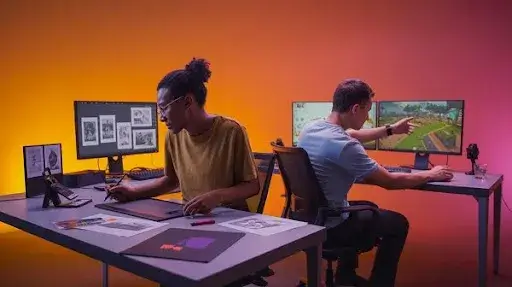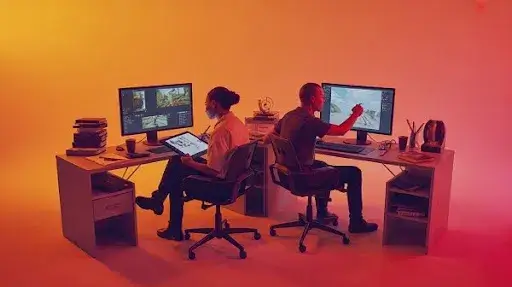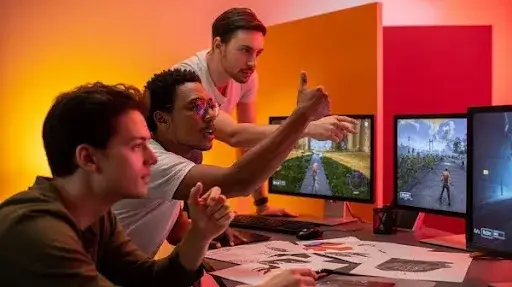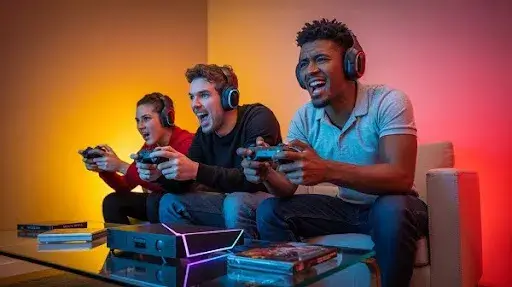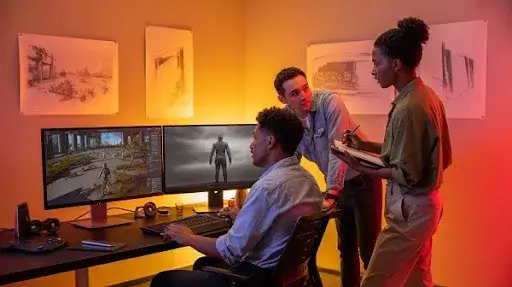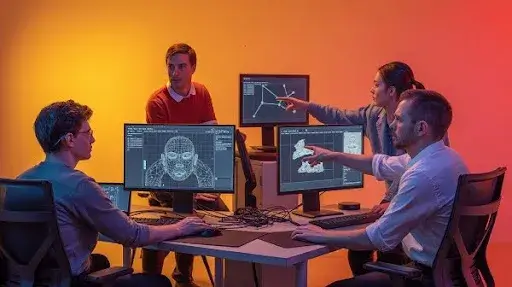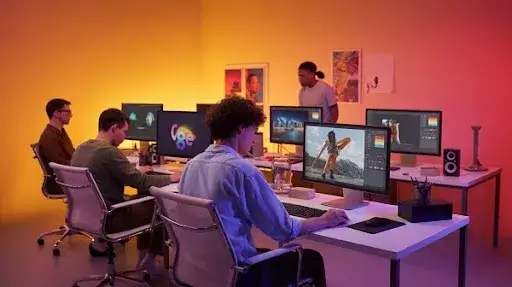Some game studios waste 8 months fixing levels that look good but don’t play good. That time-killing rewrite almost never happens because the game idea was bad.
It happens because level design and art integration in games didn’t shake hands early. Design said, “Build a maze.” Art said, “Make it pretty.” No one said, “Will players understand it?”
Good games are not built on art alone. Not on game mechanics alone either. They’re built in the gray area where visual and gameplay elements actually speak the same language. That bridge between pretty and playable is where games survive or quietly die.
Level Design and Art Integration in Games: The Hidden Deal Breaker
Most players don’t judge a game by how many hours you spent modeling rocks or polishing shadows.
They judge it with questions like:
- Where the heck do I go?
- Why did I die there?
- Why does this look important if it does nothing?
If the answers frustrate them, the game loses. Simple as that.
Studios that invest in level design and art integration in games don’t just ship games. They ship experiences that don’t make players fight the controls or visuals. At Prolific Studio, this is the foundation of every project. Not an afterthought. Not a polish phase. The backbone.
Create Amazing Games by Making Art and Level Design Co-Exist
A good level is:
- Easy to understand without instructions
- Fun for the first 10 minutes, not just after 2 hours
- Built to guide, not confuse
- Aligned with the art style without hiding gameplay
A good art direction is:
- A visual guide, not a distraction
- A storytelling layer, not a decoration layer
- A gameplay assistant in disguise
When both combine well, players don’t notice the guidance. They just play. And enjoy. And keep playing. That’s how you create amazing games that don’t end up abandoned on someone’s home screen.
How Level Design Supports Different Kinds of Games
Not all games should look or feel the same. A horror game needs different art DNA than a puzzle game. 2D platformers don’t guide people the same way 3D shooters do. Here’s what smart integration looks like based on game type:
For Horror Game Titles
- Shadows are not decoration; they are road signs
- Silence is a level design tool
- Clutter must scare, not confuse
- Lighting must whisper, not scream
For Puzzle & Brain Games
- Clean UI, clean layouts
- No visual noise
- Every object must earn its place
For 2D Animation-Based Games
- Silhouettes matter more than detail
- Colors carry meaning, not just beauty
- Animations teach gameplay, not show off
For 3D Animation Games
- Depth must guide direction
- Camera must assist the player, not compete with them
- 3D modeling must serve movement, not block it
Game Art Service vs Gameplay Intent
A common mistake in game art service pipelines:
- Art team creates stunning visuals
- The design team then tries to fit gameplay into the art
That’s like decorating a house before building the floor plan. The correct order?
- Build the playable blueprint
- Test if players understand it
- Add art that supports the blueprint
- Upgrade art without blocking gameplay signals
This keeps the game playable first, beautiful second.
Why Visual and Gameplay Elements Must Share the Same Brain
Think of a locked in-game door.
- If it’s glowing red, players assume danger.
- If it looks cracked, they assume it breaks.
- If it’s neon yellow, they assume it opens.
Now, if the door looks breakable but isn’t, players get annoyed. If it’s clearly a key door but opens by shooting, players get annoyed. Because the art promised one thing. The game delivered another.
The golden rule: Don’t let art lie to the player, even by accident.
The 3-Layer Method for Level Design and Art Integration in Games
This method keeps art and level design organized and aligned.
Layer 1: Play First (No Looks, All Function)
- Grey boxes only
- No textures
- No fancy lighting
- Just movement, jumps, timing, combat, spacing
Layer 2: Visual Communication Comes Next
Now add art that explains gameplay:
- Colors that mark danger
- Lights that highlight paths
- Sizes that show importance
- Shapes that show interaction
Layer 3: Atmosphere Last
This is where you add:
- Background art
- Details
- 2D animation flourishes
- 3D animation moments
- Polish, particles, drama
The mistake most studios make? They start at Layer 3.
Lighting That Guides, Not Distracts
Use light like an invisible road sign:
- Bright = go here
- Dim = background only
- Warm = safe zone
- Cold = challenge zone
A 20–30% light difference between the path and background is enough. You don’t need laser beams or arrows floating in the air.
Major Game Assets Need a Purpose Beyond Beauty
Every major game asset should answer at least one of these:
- Can the player use this?
- Can the player learn from this?
- Does this warn or reward the player?
- Does this support movement or decisions?
If the answer is no, it doesn’t belong in a level. Add it to the pause screen art gallery, not the playable space.
Fine-Tune Gameplay Before Final Art
A common schedule mistake:
- Art builds 100% assets
- Design tries to make them work
- 40% gets scrapped
- Timelines explode
A better schedule:
- Test gameplay with placeholders
- Approve routes, puzzles, timings
- Build final art only for approved sections
- Test again
- Upgrade graphics without redesigning the level
This alone can save months of production time.
Supporting Gameplay Effectively Using Game Camera Setups
Bad camera = bad game. No exceptions.
Camera rules to follow:
- Never hide the path the player must take
- Don’t zoom so close that navigation becomes guessing
- Transition smoothly, not dramatically
- Frame the objective without telling the player “LOOK HERE”
Players like to feel smart. Let them “discover” what you actually guided them to.
Tips and Tricks for Level Design and Art Integration
Here are some non-negotiables:
- Test with 5 new players every 2 weeks
- Remove anything players call “confusing clutter”
- Lock color and lighting rules early
- Don’t hide paths behind decoration
- If players ask “Is this important?” make it clearer
Level Design and Art Integration Tools Worth Using
Studios that struggle with integration often struggle with collaboration.
Tool stack that works well:
- Unity or Unreal (level building + gameplay)
- Blender or Maya (3D modeling + animation)
- Photoshop or Krita (textures, UI assets)
- Git or Perforce (team sync, version control)
This combo keeps art, motion, and level design in the same conversation instead of separate planets.
Game Trailer Services: The Proof Stage for Art + Level Quality
A good game trailer services expose bad level design instantly.
If a 60-second game trailer service video makes viewers ask:
- What is the objective?
- Why are they doing that?
- Where are they going?
Then the game itself has clarity issues. Trailers are not just marketing. They are a level design lie detector.
Level Design and Art Integration in Games at the Player’s Eye Level
Players don’t narrate their experience like developers do. They don’t say, “The environment lacked cohesive art integration.” They just say, “This game feels annoying.”
That “annoying” usually means:
- They got lost
- Something looked clickable, but wasn’t
- The camera fought them
- The art looked great, but didn’t help them play better
- Or worse, it distracted them
When level design and art integration in games are done right, players never notice the work. They only notice the fun. That’s the real target. And that’s exactly where most studios miss the mark.
Gameplay First, Visual Flex Second
Too many studios chase the “cool screenshot” moment too early. A neon city alley drenched in rain. A 300-foot ancient statue. A hyper-detailed forest with 10,000 leaves per branch. Looks great. Plays awful. Good visuals are not the ones that look expensive. They’re the ones that quietly help the player make decisions without thinking too hard.
That’s the difference between:
- Players saying, “Wow, this looks insane.”
- And players saying, “Wow, this feels insane.”
One gets screenshots. The other gets loyal fans. Prolific Studio builds for the second reaction.
Game Art Service That Supports the Mission, Not Fights It
A reliable game art service doesn’t just hand over good-looking assets. It hands over useful assets:
- Assets that players can understand at a glance
- Assets that guide movement naturally
- Assets that don’t hijack attention for the wrong reasons
- Assets that don’t block camera angles or player movement
At Prolific Studio, art isn’t on a collision course with level design. It’s on the same team, playing the same mission.
Understanding Different Kinds of Games & Their Visual DNA
Each game genre speaks a different visual language. A horror game will use shadows, silence, tight spaces, and uncomfortable camera angles to make players feel watched. A fast combat game will prioritize wide visibility, clean enemy silhouettes, and readable attack wind-ups. A strategy game will simplify chaos so the brain doesn’t melt after 3 minutes of gameplay.
Even famous cartoon characters follow visual logic.
- Big eyes → emotional clarity.
- Bold colors → instant recognition.
- Exaggerated limbs → readable movement.
- No detail exists just to exist.
Even stylized games are designed with a purpose. Nothing is random.
Supporting Gameplay Effectively Without Babysitting the Player
The goal is not to handhold. The goal is to make direction feel like instinct. That means:
- Paths look like paths
- Danger looks like danger
- Buttons look pressable
- Platforms look jumpable
- Secrets look suspicious
- Dead ends look… dead
When visual and gameplay elements are aligned, players feel smart. When they aren’t, players feel tricked. One builds ego. The other builds frustration. Pick wisely.
Frequently Asked Questions
Why is level design and art integration in games so important?
Because it decides if players enjoy the game or fight the game. When visuals and gameplay don’t connect, players leave, even if the art is impressive.
What role does a game art service play in level design?
It supplies visual tools that guide players, support movement, and communicate goals. Good art serves gameplay, not just looks good on screenshots.
How do 2D animation and 3D animation influence level design?
2D helps express quick feedback and UI clarity. 3D brings weight, movement, and environment interaction. Both must support gameplay understanding, not distract from it.
What makes a horror game level design effective?
Controlled lighting, sound timing, intentional clutter, and shadows that guide instead of confuse. The goal is tension, not disorientation.
What are the best level design and art integration tools?
Unity or Unreal for building, Blender/Maya for asset creation, Photoshop/Krita for textures/UI, and Git/Perforce for team workflow.
How do game camera setups impact player experience?
They decide what players focus on, how safe they feel moving, and how well they understand action. Good cameras feel invisible but intentional.
Final Words
Players don’t fall in love with textures or lighting. They fall in love with moments. Moments they understand. Moments that feel fair. Moments that look great and play even better.
That magic only happens when level design and art integration in games are treated as one shared craft, not two separate departments fighting for attention. At Prolific Studio, the goal isn’t to build another game that looks good.
It’s to build a game that stays with players, the kind that gets talked about, remembered, replayed, and recommended without marketing pushing it. If you want a team that treats gameplay and art like equal partners, not awkward strangers sharing office space…
Let’s make something worth playing. Not just worth posting.
Related Articles:

